L4: Kreb cycle and Electron Transport Chain
1/29
There's no tags or description
Looks like no tags are added yet.
Name | Mastery | Learn | Test | Matching | Spaced |
|---|
No study sessions yet.
30 Terms
Describe Pyruvate
End product of glycolysis
A simple alpha-keto acid (3C)
Contains 2 reactive groups: Ketone group (C=O) and Carboxyl group (-COOH)
Each group can be further reduced or acted upon to form complex molecules and polymers.
Draw the structure of pyruvate
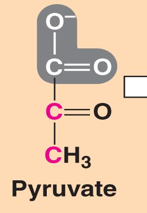
What happens to pyruvate after glycolysis under aerobic conditions?
Oxidative decarboxylation
After glycolysis, pyruvate (3C) transported via transport protein into mitochondria
In mitochondria, pyruvate dehydrogenase requires coenzyme A to convert pyruvate to Acetyl CoA (2C)
CO2 is produced and NAD+ is reduced to NADH
Acetyl CoA enters Krebs cycle
Note: 2x pyruvate → 2NADH = 2x3ATP (ETC) decarboxylation because pyruvate (3C) is converted to acetyl CoA (2C) and lost 1C to form CO2
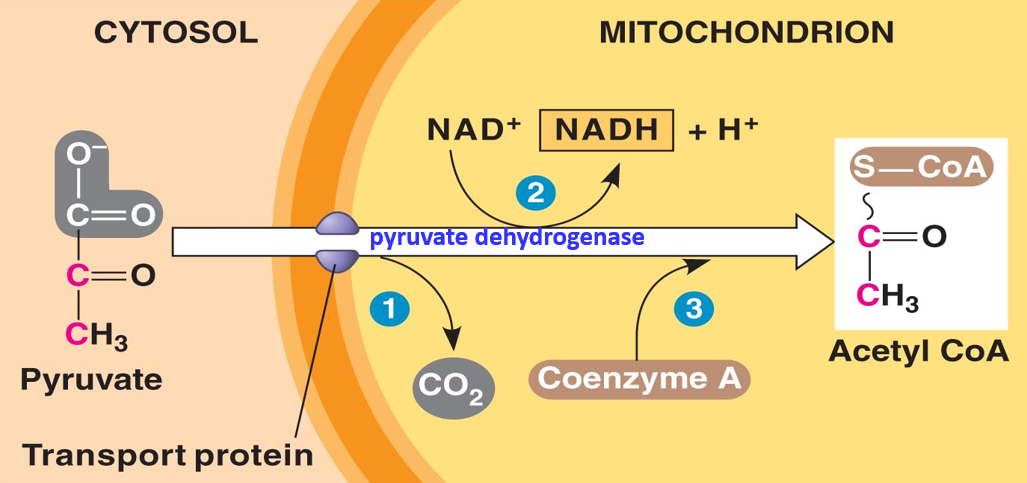
What is the full name of acetyl CoA?
Acetyl Coenzyme A
What is Pi?
Inorganic phosphate
What is GTP?
Guanosine Triphosphate
What is ATP?
Adenosine Triphosphate
What is the Krebs cycle also known as?
Tricarboxylic acid (TCA) cycle or Citric acid cycle
Describe the process of Krebs cycle. Draw out the entire Krebs cycle with the structures of each step.
Acetyl CoA (2C) combines with oxaloacetate (4C) to form citrate/citric acid (6C)
Citrate/ Citric acid (6C) loses 1 H2O and gains another, as citrate is converted into its isomer isocitrate (6C) by aconitase
Isocitrate (6C) is oxidized to produce alpha-ketoglutarate (5C) + 1 CO2 + 2 electrons. Electrons then reduce NAD+ to NADH
alpha-ketoglutarate (5C) is oxidized to produced succinyl CoA (4C) + CO2 + 2 electrons by alpha-ketoglutarate dehydrogenase
Electrons reduces NAD+ to NADH
Succinyl CoA (4C) is converted to succinate (4C) by succinyl CoA synthase. A phosphate group is substituted for Coenzyme A → a high energy bond is formed. This energy is used in substrate level phosphorylation to form GTP or ATP
Succinate (4C) is converted to fumarate (4C) by succinate dehydrogenase (dehydration process). 2H transferred to FAD to produce FADH2. Unlike NADH, FADH2 remains attached to the succinate dehydrogenase, electrons of FADH2 is transported directly to electron transport chain while attached to the enzyme. The energy contained in the electrons of these atoms is insufficient to reduce NAD+ but adequate to reduce FAD.
Fumarate (4C) is converted to Malate (4C) by fumarase with the addition of water.
Malate (4C) is oxidized to produce oxaloacetate by malate dehydrogenase. NAD+ is converted to NADH. Oxaloacetate formed can then bind with Acetyl CoA again to form citrate, cycle repeats.
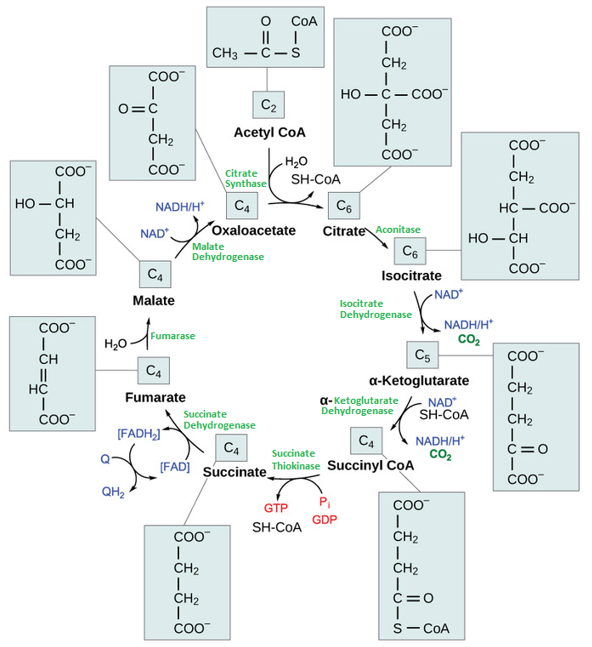
What is oxidative decarboxylation? Which steps in the Krebs cycle are oxidative decarboxylation steps? Why?
Oxidative decarboxylation → Molecules are oxidized and loses a carbon
Steps that remove carbon
Step 3: Isocitrate is oxidized to form alpha-ketoglutarate
Step 4: alpha-ketoglutarate is oxidized to form succinyl CoA.
These steps release electrons that reduce NAD+ to NADH and release carboxyl groups that form CO2 molecules.
Which step in the Krebs cycle is a substrate-level phosphorylation step?
Succinyl CoA is converted to Succinate (GDP to GTP)
In summary what are we doing from Step 1 - 4, Step 5 - 9 of the Kreb cycle? (What is the purpose of the Kreb cycle)
From step 1 - Step 4, we completely oxidize Acetyl CoA (2C) to succinyl CoA (4C)
From step 5 - step 9, we convert succinyl CoA back into Oxaloacetate
To produce energy
Completely oxidize Acetyl CoA molecule
What intermediates for anabolism are formed during the TCA cycle? What molecules can they be used to form? (OCAS)
Each intermediate contains reactive groups
Oxaloacetate → Aspartate → Other amino acids, purines, pyrimidines
Citrate → Fatty acids (occurs in cytosol), sterols
Alpha-ketoglutarate → Glutamate → Other amino acids → Purines
Succinyl CoA → Porphyrins, Heme, Chlorophyll
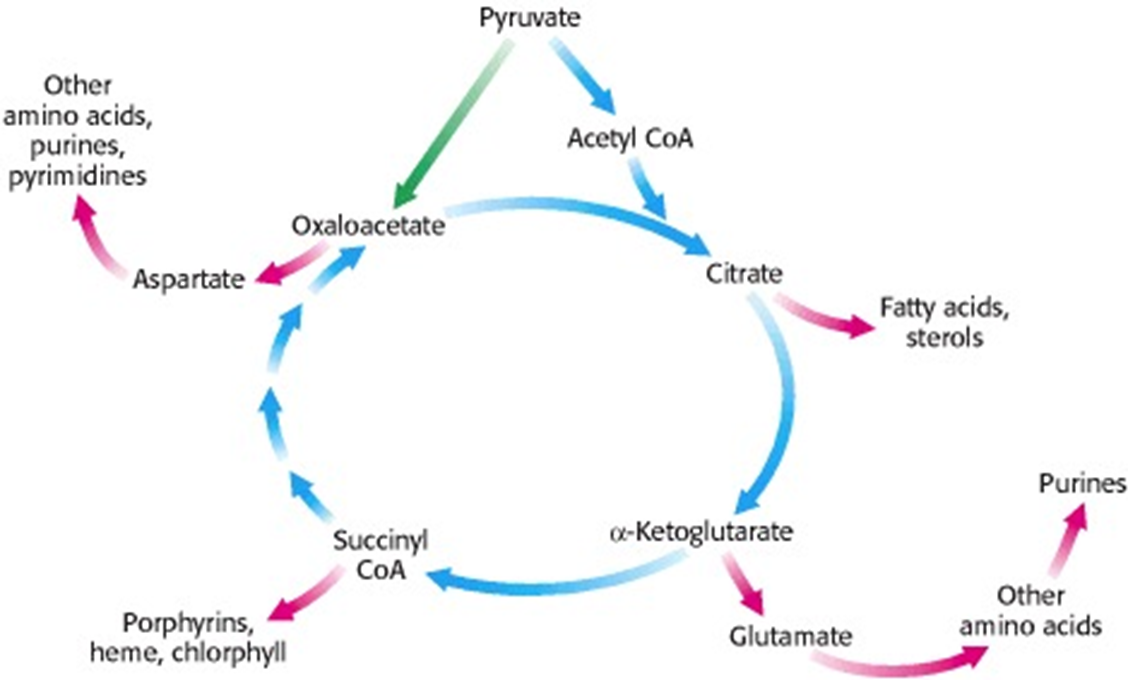
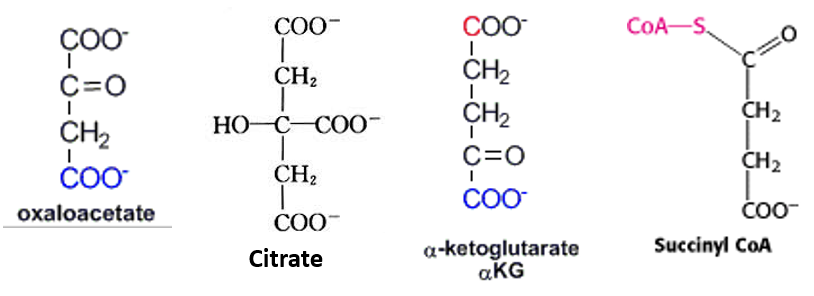
Summarize the products of the Kreb cycle
4-carbon Anabolic intermediates
2 molecules of CO2
Energy in form of GTP, NADH, FADH2
For every Acetyl CoA metabolized:
1 GTP = 1 ATP
3 NADH = 9 ATP
1 FADH2 = 2 ATP
Total 12 ATP produced
Complete oxidation of 1 molecule of glucose → 24 ATP (2 pyruvate → 2 acetyl CoA) from TCA cycle
What is the total energy yield under Aerobic conditions?
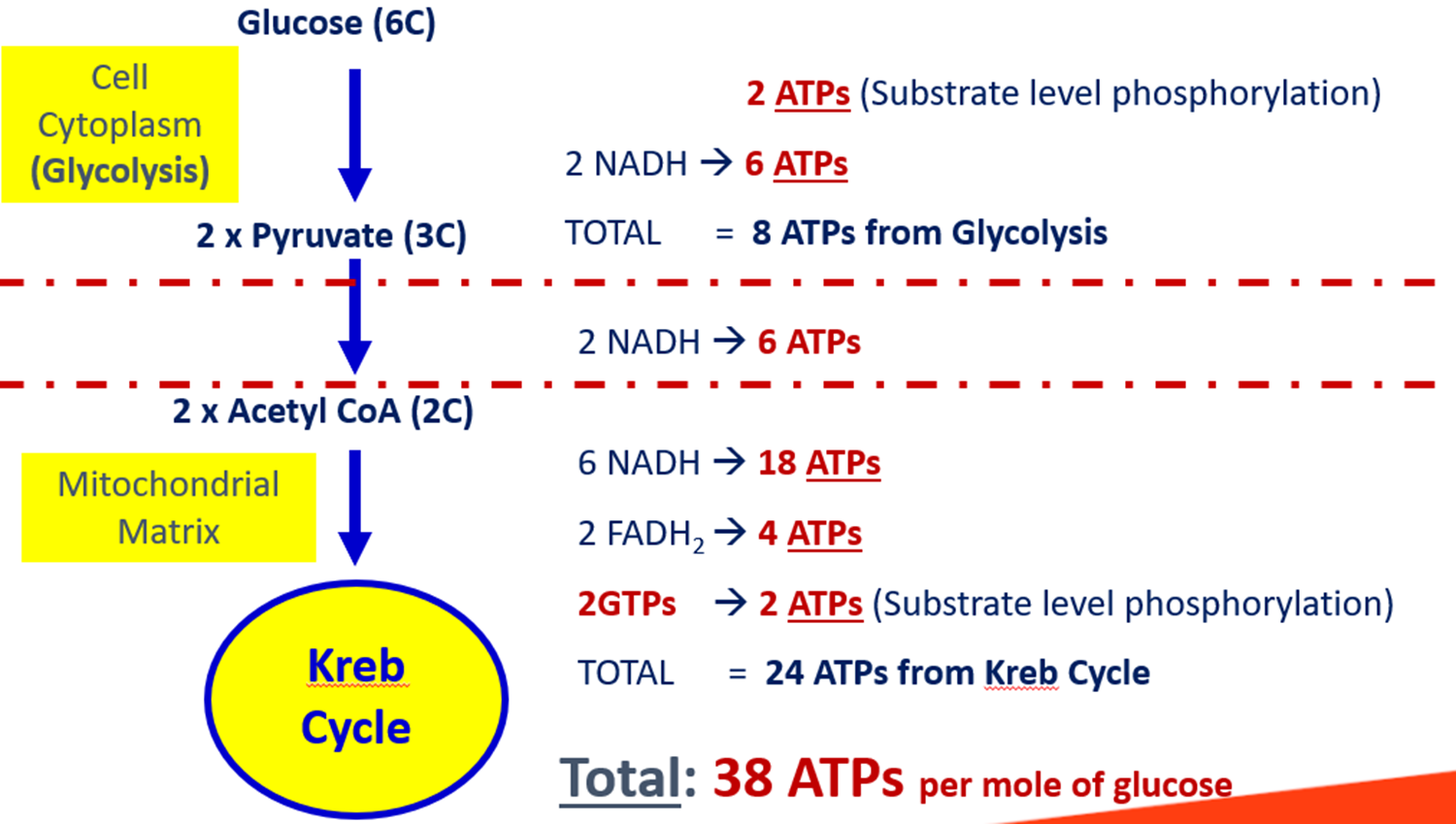
Oxidative decarboxylation of pyruvate: Each Pyruvate molecule is converted to Acetyl-CoA, producing 1 NADH per pyruvate
Hence 2NADH produced = 6ATP
What is the total energy yield under Anaerobic conditions?
NADH molecule comes from glycolysis (2NADH required for fermentation, 8ATP-6ATP = 2ATP)
No ATP is produced during fermentation
Overall 2 ATPs produced from glycolysis/substrate level phosphorylation

What happens to lactate/lactic acid after anaerobic respiration? What is this cycle known as?
Cori Cycle
Under oxygen-limiting conditions, pyruvate is converted to lactic acid during fermentation
Accumulation of lactic acid causes muscle aches
Lactic acid is transported out of muscle cells and carried by blood to the liver
In the liver, lactate is converted back to pyruvate
Pyruvate converted back to glucose via gluconeogenesis and is released back to the blood stream to be taken up by the muscles and other tissues
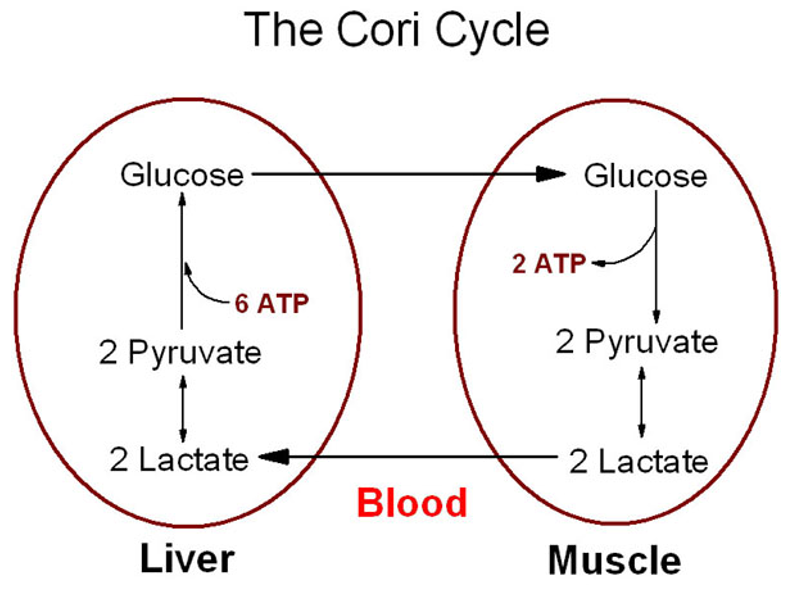
What is the mitochondria comprised of and how do they help in Electron Transport Chain (ETC) / Respiratory chain?
Proteins (electron carriers and proton pumps) found on inner membrane of mitochondria
ADP-ATP translocase (Transport proteins) → Transports ADP and Pi into the matrix, Transports newly synthesized ATP out of the matrix
Specific transporters → Carry pyruvate, fatty acids and amino acids into the matrix
Cristae (folds of inner membrane) → Increases surface area to allow for more ETC for more efficient function
What is the function of electron transport chain?
To reoxidize NADH/FADH2 back to NAD+ and FAD (with oxygen being the final electron acceptor)
O2 is reduced to H2O
To provide proton gradient for oxidative phosphorylation (involved in producing ATP)
Movement of electrons from one complex to another results in pumping of H+ into the intermembrane space.
Where does the Electron Transport Chain get the NADH/FADH2 from?
Glycolysis: 2 NADH
Oxidative decarboxylation of pyruvate: 1NADH (X2 per pyruvate)
Pyruvate → Acetyl CoA
Krebs Cycle (6NADH + 2FADH2)
What is oxidative phosphorylation?
Oxidative: Electron transfer from NADH / FADH2 to O2 via electron carrier proteins Phosphorylation: Synthesis of ATP (ADP + P → ATP), Dependent on O2 so its Oxidative
Occurs in mitochondria and is the process of ETC + ATP synthase
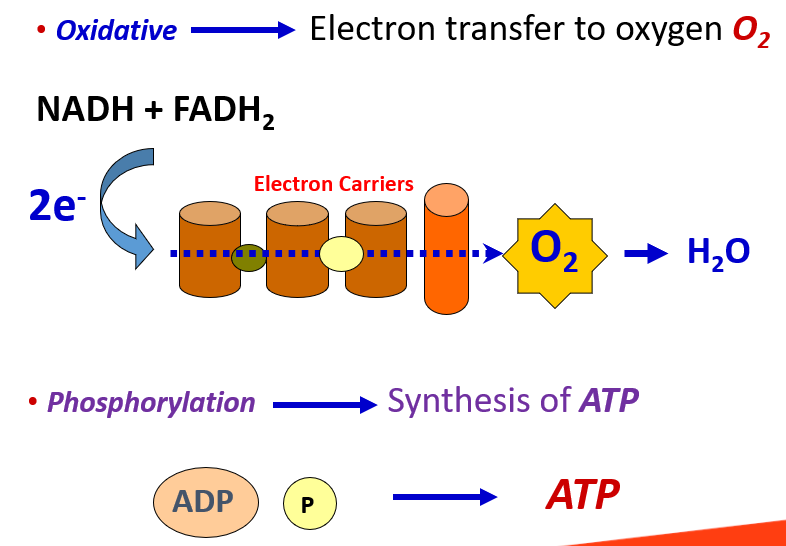
What is the Electron Transport Chain composed of?
Proton pumps
Complex I
Complex II
Complex IV
Electron carriers
Ubiquinone
Cytochrome C
Complex II
What is the function of ATP synthase?
Allows for movement of H+ ions from Intermembrane space into matrix through ATP synthase which drives ATP synthesis
How is ATP synthesized during oxidative phosphorylation?
In ETC:
NADH donates e- to Complex I (NADH dehydrogenase) to form NAD+
FADH2 donates 2e- to Complex II to form FAD
Electrons move through complexes via Ubiquinone and Cytochrome C with oxygen being the terminal electron acceptor.
This allows for H+ to be pumped from the mitochondria matrix to the intermembrane space.
H+ cannot return to matrix as inner membrane is impermeable to H+.
Accumulation of H+ in intermembrane space results in formation of a proton gradient.
H+ can only move from the intermembrane space into mitochondrial matrix via ATP synthase along the proton gradient
Movement of H+ ions via ATP synthase drives ATP synthesis (ADP + Pi → ATP).

What are the differences between substrate level phosphorylation and oxidative phosphorylation?
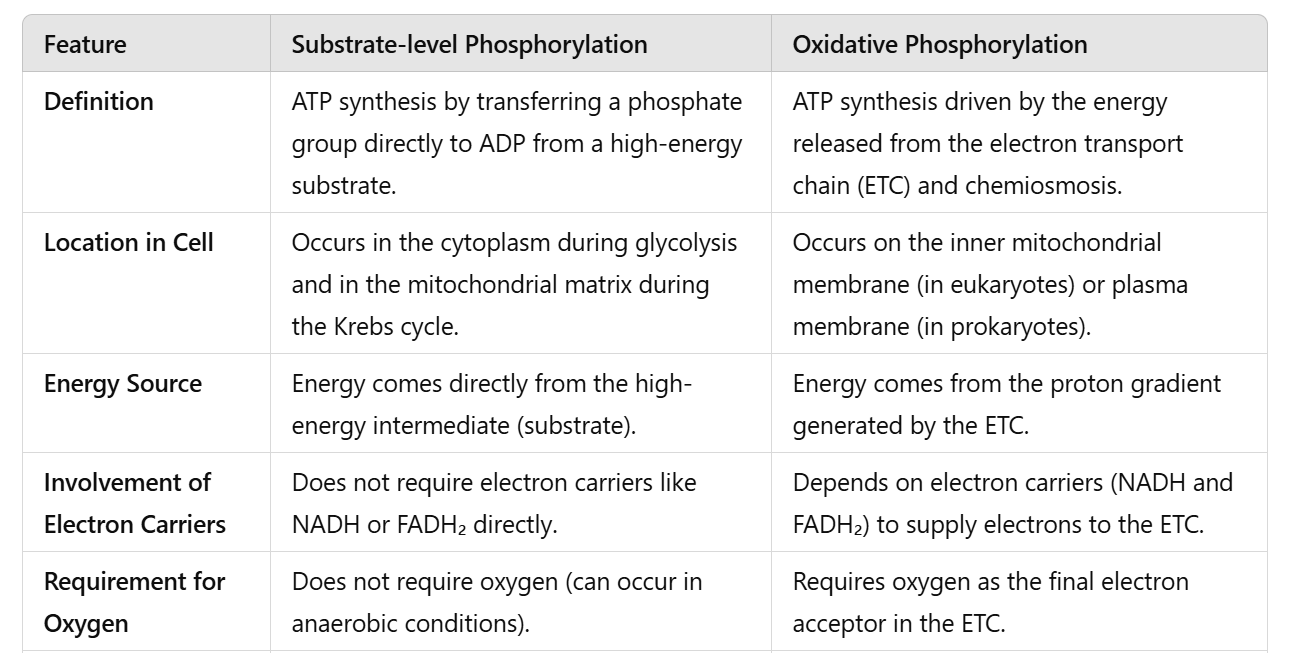
What is the proton motive force?
Movement of protons back into the mitochondrial matrix.
ETC and ATP synthase are biochemically separate systems, linked only by a proton motive force.
What is the structure of Complex 2 (succinate dehydrogenase) and what does it do ?
2 transmembrane subunits (SDHC & SDHD)
Heme b & Ubiquinone is sandwiched between SDHC & SDHB
2 matrix subunits (SDHA & SDHB)
SDHA contains a bound FAD cofactor and is the binding site for succinate
SDHB has 3 Fe-S centers
Function → Forms a direct link with the Kreb cycle. To transfer electrons from succinate (in Kreb cycle) through complex II to Ubiquinone and then to complex III without pumping of H+
When succinate is converted to Fumarate in the Krebs cycle, electron pairs move from succinate to FAD cofactor, reducing FAD to FADH2
Electrons is transferred from FADH2 to 3 Fe-S centers.
Heme b prevents reactive oxygen species formation and does not participate in electron transfer
Electrons is transferred from Fe-S centers to coenzyme Ubiquinone, resulting in the formation of QH2
QH2 then transfers e- to complex III
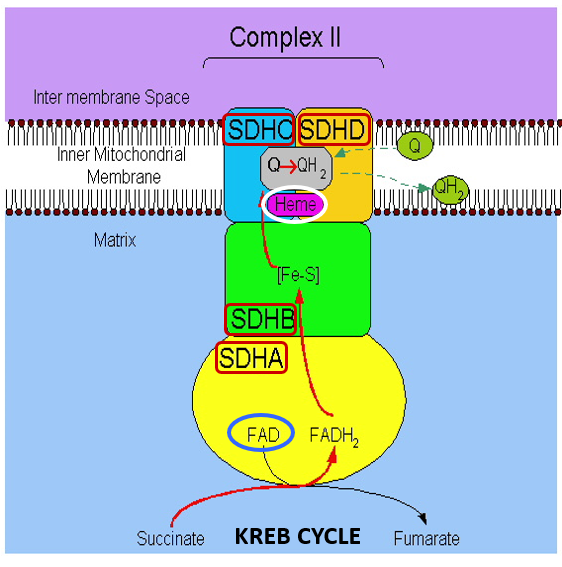
What is a proton pump?
Electrons transfer through complexes I, III, IV via Cytochrome C and Ubiquinone with oxygen being final electron acceptor which allows for H+ to pump into intermembrane space from mitochondrial matrix
Electron transport in ETC and ATP synthesis by ATP Synthase are coupled by a _______ across the inner mitochondrial membrane.
proton (H+) gradient
Oxidation and phosphorylation are coupled by a ________.
Proton gradient